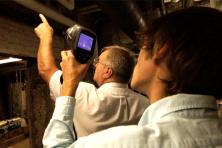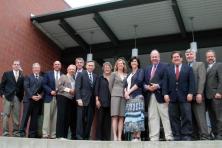A capacity crowd of 160 thought leaders and innovators gathered on June 10, 2013 at the University of Washington's Center for Urban Horticulture in Seattle for the first-ever Northwest Biocarbon Summit.
Steve Whitney, Program Officer at the Bullitt Foundation, kicked off the day, uttering what became both a watchword for and a challenge embraced by Summit participants, declaring the gathering to be “a silo-busting event.”
Whitney asked participants to identify the sectors they work in and we learned that they hailed from the widest range – forestry, agriculture, community development, watershed restoration, organics recycling, biochar, aquatic resources, and urban stormwater management. Strong contingents from each area revealed a remarkable balance across the sectors, all united by their membership in the biocarbon community.
While we inevitably gravitate toward silos and spend most of our time interacting with those who share our expertise, Steve challenged the assembled to step out of their comfort zones to connect with people across silos and work to build a more integrated approach to advance biocarbon as the second critical solution to the global climate crisis.
Rhys Roth of Climate Solutions grounded the day’s proceedings in the big picture of global climate change, the biocarbon imperative, and the portfolio of biocarbon solutions. The best biocarbon solutions offer multiple economic, social, and environmental benefits and make sense from many different angles. He noted that the Northwest Biocarbon Initiative organized the Summit to advance the Northwest as a leading incubator and laboratory for biocarbon innovation.
Rhys was followed by David Montgomery, “MacArthur Genius” and author of Dirt: The Erosion of Civilizations, who gave a riveting presentation, leading off with a Franklin Delano Roosevelt quote from February 1937 in which the President told all state governors that "the nation that destroys its soil destroys itself." Montgomery then proceeded to explain why soil—humble, lowly, everyday dirt—is an essential, irreplaceable, and strategic resource, as well as our secret weapon in the battle against climate change, as outlined in his guest blog.
A remarkable series of “Speed Talks” by real-world Northwest practitioners then ensued, bringing to life the full portfolio of biocarbon solutions. See "Fast Talking Innovators Show the Way to Our Biocarbon Future" to learn about these eight fascinating presentations, with links to the slides the speakers presented.
In the afternoon, participants had the opportunity to attend two sessions, one on the economics of biocarbon and the other on how the Northwest is on the cutting edge of the rapidly emerging field of natural infrastructure, which is fueling investment in greening the urbanized landscape and restoring natural functions across a wide range of landscapes.
In the economics session, moderated by Brent Davies of Ecotrust, participants were treated to an incredibly stimulating conversation about the true value of capital, especially natural capital. Bullitt's Steve Whitney led off the hour quoting the famous Oscar Wilde answer to the question "What is a cynic?" (Answer: A man who knows the price of everything and the value of nothing.)
But Whitney reminded the audience that Wilde went on to say that a sentimentalist "is a man who sees an absurd value in everything, and doesn't know the marketplace of any single thing,” and used this frame to make the point that in order to understand the market value of something one must know the true cost to produce it and the price purchasers are willing to pay for it. But if all of the costs of the good are not fully accounted for in the price (for example, the value of the natural capital of biocarbon), then the marketplace cannot reflect its true value.
This was an excellent segue into Ecotrust's Noah Enelow terrific talk on the economics of restoration, which his research has found contributes significantly to new and existing industries (e.g., fisheries, recreation, tourism, biomass) and local economies by creating demand for local labor and local materials.
Enelow explained that restoration work often takes place in rural areas, across a variety of education levels, is extremely labor-intensive, and the money that is involved in the projects stays local: 80 to 90 cents out of every dollar stays in the community and every dollar paid to a worker generates $2.20-2.40 in local economic activity!
Tony DeFalco of Verde rounded out the panel with an eye-opening presentation on using natural infrastructure as an anti-poverty strategy. He noted that where environmental disparities exist in a city, the communities inevitably lag behind economically as well. DeFalco is the Coordinator for the Living Cully Ecodistrict project, which has a quadruple bottom line: equity, economic benefit; environmental and health improvement; and enterprise development. He said that Living Cully is an example of how low income people can build wealth.
The second afternoon session moderated by Becky Kelley, Deputy Director of the Washington Environmental Council and Fletcher Beaudoin, Sustainability Partnerships Director at Portland State University, provided examples of the full spectrum of green infrastructure strategies across various landscapes, identifying common barriers, data needs, and opportunities to collaborate across different strategies.
Mike Houck, who directs the Urban Greenspaces Institute, described issues and opportunities for urban green infrastructure; Paula Swedeen, forest ecosystem services consultant to the Washington Environmental Council talked about how to work with timber companies; Chris Davis, Director of Conservation for The Nature Conservancy described the communications lessons learned through restoring floodplains.
Key takeaways from the session include: there is both a huge need and opportunity to communicate the multiple benefits of natural infrastructure; natural infrastructure projects require creative approaches and multiple resources and funding; and, the challenge ahead is to make a natural infrastructure approach mainstream and a normal part of any major decisions around development.
To complete the afternoon sessions, Amanda Stanley of the Wilburforce Foundation moderated a discussion about the state of research on natural infrastructure with some of the region's top scientists: Chad Krueger who directs the Washington State University's Center for Sustaining Agriculture and Natural Resources; Ron Thom, the Team Leader for PNNL's Marine Sciences Laboratory's Coastal Ecosystem Research Group; and Dominick DellaSala, the Chief Scientist and President of the Geos Institute, all shared insights into the vital biocarbon work underway in agriculture, coastal carbon (also known as "blue carbon"), and forestry. Some key observations:
- Krueger: We do have good scientific evidence that we can mitigate carbon emissions through biocarbon.
- Thom: 50 percent of total ocean carbon burial happens in coastal areas that cover only 2 percent of the ocean surface (!)
- DellaSala: Most of the carbon-dense forests in the United States are not protected, and the carbon in US forests is underappreciated globally.
It's impossible to summarize in one blog the insights and information that panelists and speakers conveyed to participants at the premier Northwest Biocarbon Summit. Fortunately, you can access all of the presentations and see videos of the talks to experience for yourself the rich exchange of information among a wide cross section of practitioners in the emerging and extremely exciting field of biocarbon.




